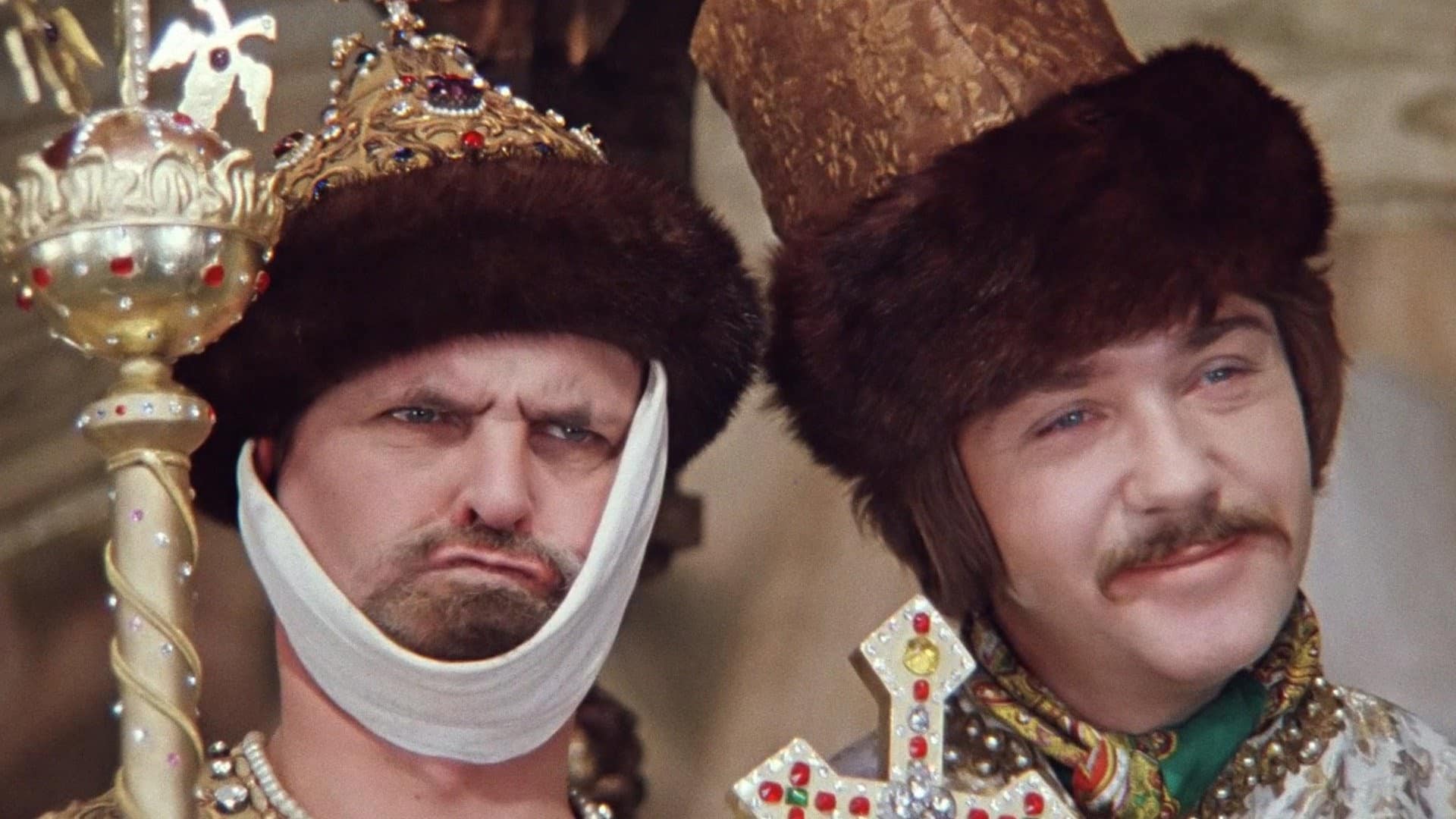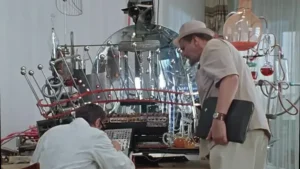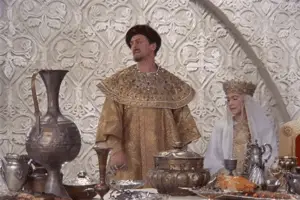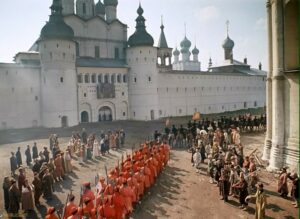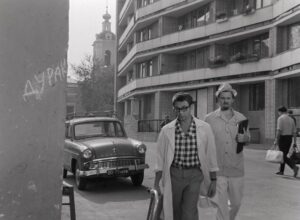Ivan Vasilievich Changes Profession (Иван Васильевич меняет профессию) is a legendary Russian-language comedy film released in 1973 under the USSR. It is is available for free on YouTube with English and Russian subtitles and HD quality.
At once a comedy, a sci-fi, and a (very loosely) period piece, its surreal storyline spans both the 20th and 16th centuries. The story begins when Alexander Sergeyevich Timofeyev (Shurik), a 20th-century engineer, tries to launch the time machine he created, which leads to explosions and his loss of consciousness. He opens a portal to 1500s Russia and accidentally sends Ivan Vasilievich Bunsha, manager of his apartment complex through it. By surprise, the manager is a dead ringer for none other than Ivan IV Vasilievich, better known as Ivan the Terrible, tsar of 16th century Russia. There is another person transported with Ivan Vasilievich, a conman named George Miloslavsky, who happened to be robbing the apartment next door to Shurik when the machine was activated. The conman assumes the role of the apartment manager’s advisor as the bungling man is forced to assume the role of tsar. Moreover, Ivan the Terrible appears in 1973 Moscow, thus swapping places with the other Ivan Vasilievich. Needless to say, chaos ensues.
More than 60 million viewers watched the film in the very first year, and it became one of the most famous and well-attended films in the USSR during the 1970s. Even today, Ivan Vasilievich Changes Profession maintains its popularity because of its unique time travel plot as well as its admirable cast and cultural value. It is one of a handful of classic films that are aired in rotation during the high-viewership long New Year celebrations in Russia, meaning that it is recognizable and even viewed by younger generations of Russians as well.
Despite its popularity, Ivan Vasilievich did not receive any awards. However, it had a great premiere in several other countries in the 1970s besides the USSR, including the United States. For modern audiences, the film scores an impressive 8.7 out of 10 in Kinopoisk, 8.2 in IMBd, and 4.5 out of 5 in Amazon.
Leonid Gaidai directed this film. He was a well-known and valued Soviet Union comedy film director, producer, and screenwriter who constantly broke records in sales and theater attendance. Gaidai often worked on projects that are related to each other, with an ongoing plot and the same characters. Several other movies were associated with Shurik as well, including the 1966 comedy Prisoner of the Caucasus or Shurik’s New Adventures (Кавказская пленница, или Новые приключения Шурика) and Operation “Y” and Other Adventures of Shurik (Операция «Ы» и другие приключения Шурика) of 1965.
What made this film legendary was its all-star cast. Shurik was played by Alexander Demyanenko, who already already starred in the 1968 film Sullen River (Угрюм-река) and Empty Flight (Порожний рейс) of 1962. Yuriy Yakovlev performed the Ivans, manager of the apartment complex, and Tsar Ivan the Terrible. Yakovlev was already famous for his roles in several movies such as The Man from Nowhere (Человек ниоткуда), Hussar Ballad (Гусарская баллада), and many others. In fact, most of the cast was already recognizable by the time the film was shot because of their previous joint works with Gaidai. Yet some were breakout artists, including Natalia Belogortseva, who played Bunsha’s wife.
The movie was based on Mikhail Bulgakov’s play Ivan Vasilyevich, which was written in 1935. Their plots are very similar, but minor changes were accommodated before the film’s shooting, mostly to bring the current time forward to contemporary Moscow and make the film work as one of Gaidai’s serial Shurik productions. For example, the main character’s name is Alexander (Shurik) in the film version, while it is Nikolai in the original play. Some technical details are updated as well including the time machine’s look and a tape recorder being used instead of a phonograph to introduce the tsar to modern music. Furthermore, the reason for the time machine’s damage and the ending after the character wakes up from his dream are different. In the play, the last scene consists of Shpak’s apartment actually being robbed, while this detail is not present in the film.
Settings for Ivan Vasilievich Changes Profession
Most of the 16th-century scenes were shot at the white-stone Kremlin of Rostov the Great, right after its Soviet-era restoration. It could be said that this made the film more historically accurate as the Moscow Kremlin was also white during the reign of Ivan IV, and, after restoration, probably looked more like what a Kremlin would have looked like at that time in general. Further, most of the filming used interiors with the most memorable scenes in the Tsar chambers or featuring Ivan Bunsha and George Miloslavsky running through the corridors. However, the scenes shot outside make it immediately obvious that the characters are not at the Moscow Kremlin.
Most of the modern outdoor scenes were shot in Moscow at Novokuznetskaya Street, 13. At the time, the newly-built building was one of Moscow’s most modern and pronounced by city authorities as symbolizing progress. However, the building was controversial as well, with many criticizing its haphazard “wavy” appearance. To this day, the building is known by some as the “drunken house.” Also interesting is the fact that the interior apartments and corridors were far more cramped than those shown in the film. Shurik’s apartment and the building’s stairs and elevators were shot in Mosfilm’s studios. Even the view that Ivan the Terrible takes in while proclaiming Moscow’s beauty was actually taken from a room at the Hotel Ukraine in an entirely different part of Moscow. Thus, although the chosen location was a real place, it can be said that the location shown in the movie is entirely idealized and fictitious.
At the time the film was shot, the Radio Components shop where Shurik went to get parts for his time machine actually existed on the first floor of the apartment building. It has since changed hands numerous times, however, and today the space is currently occupied by a grocery store.
Ivan Vasilievich Changes Profession received predominantly positive reviews from critics at the time, which helped its success. For example, in Literaturnaya Gazeta, an article called “Sharp Peaks of Comedy” positively commented on the sets, costumes, and the time machine, stating that the original play was from the 30s, but the movie turned out to be very modern and funny. The newspaper Pravda shared that the director Gaidai did a great job once again with this new project, saying that there probably would not be a single person who wouldn’t laugh at the scenes of Ivan Vasilievich and the robber. Moreover, critic L. Ribak mentioned in the magazine Soviet Film that the way characters’ true personalities showed up after they got into an unusual situation, getting transported to a different century, was remarkable because it signifies how important the environment is to defining one’s character.
Ivan Vasilievich Changes Profession for Language Learners
Russian language learners of intermediate level will find this movie beneficial because of its use of language coupled with highly effective physical comedy. The vocabulary is diverse and includes old sayings/jokes that may create slight difficulty in understanding. This is because half of the movie is based on Ivan the Terrible and the 16th-century environment. However, the humor is simple, and most words are commonly used to this day and would be recognized by the viewer. Additionally, the characters speak clearly, and the plot flow helps the viewer catch up, even if some words may not make sense. And, of course, the physical comedy helps hold the attention even if every word might not be understood.
While its portrayal of daily life in either era is not exactly documentary, it does very much show that the people of the USSR had a sense of humor, including about themselves.
The film has been marketed in the US as Ivan Vasilievich: Back to the Future, obviously as an attempt to ride the coattails of the popular American film franchise. This is common in the Russian film industry and new films from abroad will also have their names changed in Russian to make it appear that they are somehow related to a film that has been successful before. In the US, however, most who know the film know it by the translation of the original Russian title.
Ivan Vasilievich Changes Profession is available for free on YouTube with English and Russian subtitles and HD quality.


